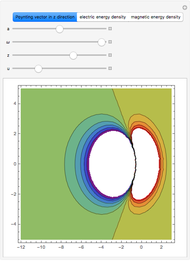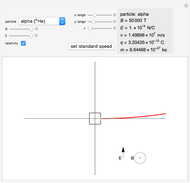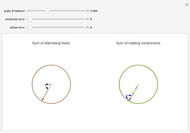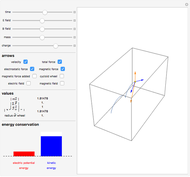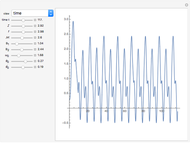Fields and Poynting Vector around a Transformer

Requires a Wolfram Notebook System
Interact on desktop, mobile and cloud with the free Wolfram Player or other Wolfram Language products.
This Demonstration shows the electric and magnetic fields and the Poynting vector distribution associated with a simplified transformer. The sinusoidal frequency of the voltage and the current are assumed to be sufficiently low so that the electric and magnetic fields can be analyzed, assuming static conditions. There is just a single turn for both the primary and secondary windings. However, you can vary the core length and winding radius, as well as the voltage, current, and power factor.
Contributed by: Y. Shibuya (October 2012)
Open content licensed under CC BY-NC-SA
Snapshots
Details
Snapshot 1: electric field
Snapshot 2: magnetic field
Snapshot 3: Poynting vector
In the simplified one-turn-to-one-turn transformer, the core is assumed to be a square, while the windings are circular filaments. The core's magnetizing current and ohmic loss in the windings are neglected (i.e. the magnetic resistance of the core and the resistance of the wire are assumed to be zero). A core width of 0.2 m and a sectional diameter  0.15 m for the wire are for visual purposes only.
0.15 m for the wire are for visual purposes only.
The electric field  is calculated assuming only the induction of main flux. Its peak is given by
is calculated assuming only the induction of main flux. Its peak is given by  , where
, where  is the terminal voltage and
is the terminal voltage and  is the distance to the core. The magnetic field
is the distance to the core. The magnetic field  is calculated by superposing the fields of two ring wires of radius
is calculated by superposing the fields of two ring wires of radius  carrying a current
carrying a current  (the formulas involve Bessel functions). Our observations are focused on the plane of the core. The average Poynting vector is calculated using
(the formulas involve Bessel functions). Our observations are focused on the plane of the core. The average Poynting vector is calculated using  , with its direction remaining within the observation plane.
, with its direction remaining within the observation plane.
The electric field increases in the vicinity of the core, while the magnetic field increases at the cross sections of the wire. They are mutually perpendicular. The direction of the Poynting vector is predominantly from the primary coil (at the left) toward the secondary (at the right).
As for the route of energy transfer from primary to secondary circuit, it appears that substantial power is carried along the core. The details depend on the transformer configuration and the observation plane.
Reference
[1] J. D. Jackson, Classical Electrodynamics, 3rd ed., New York: John Wiley & Sons, 1998.
Permanent Citation








